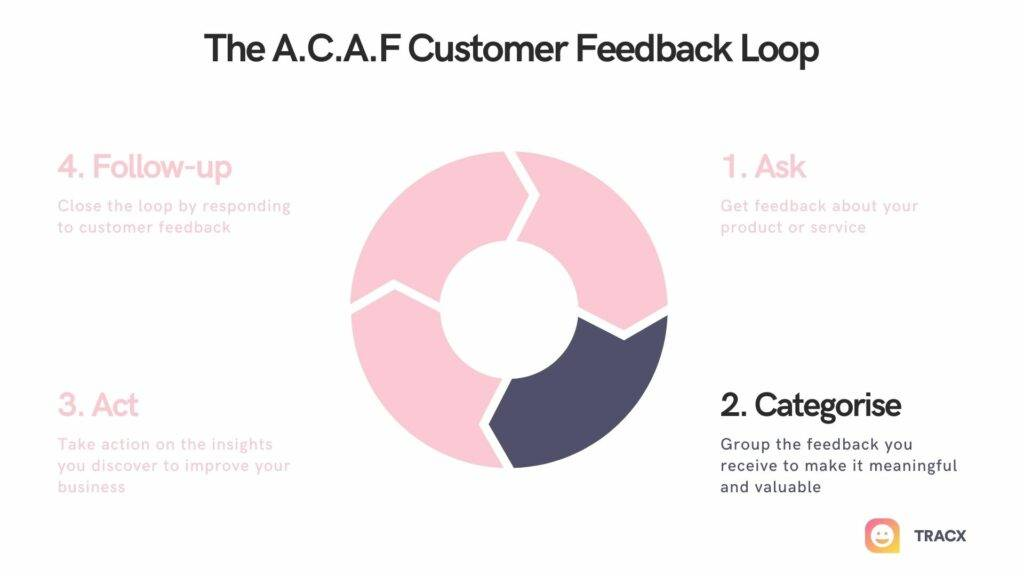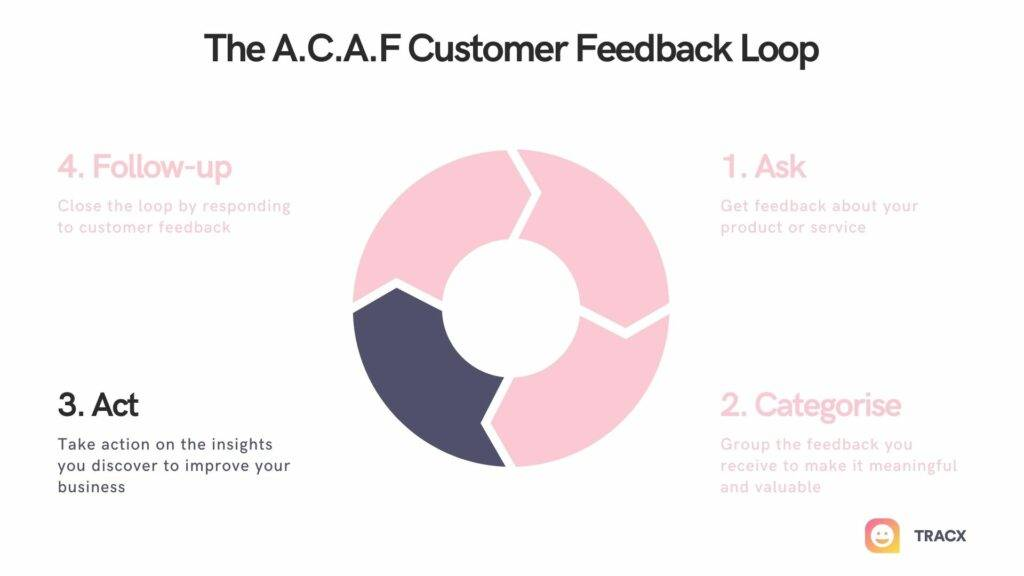Customer Feedback: How to get it, analyse it, and act on it

Table of Contents
Customer feedback is important because it gives businesses a chance to be better. It can help you improve customer satisfaction, increase sales and grow your customer base. It can be used to make changes to products, services, processes or anything else that affects the customer experience.
At TRACX, we’re experts at collecting feedback. In this guide, we’ll explain everything you need to know about customer feedback, including why it’s so important. We’ll share the secrets on how to get more of it, how to analyse it fast, and how to act on it.

Customer feedback: What it is, and why it’s so important
What is customer feedback?
In short, customer feedback is any communication from a customer about their experience with your business, product, or service. This can be either positive or negative feedback, and it’s important to listen to both types.
Why is customer feedback important?
Customer feedback helps you improve your business. It’s a way of finding out what your customers like and don’t like, so you can make changes to improve their experience.
It’s also a unique edge that you have over your competition - by actively listening to feedback from customers, you can quickly adapt and improve your offering, making your business more customer-centric.

Building a customer feedback strategy
Most people jump straight into collecting customer feedback without thinking about their strategy. But it’s important to take a step back and think about the bigger picture. A successful customer feedback strategy should always be built around your business goals.
What are your objectives?
Are you trying to understand overall trends in customer experience and satisfaction, or do you need to identify specific frustrations, pain-points, and other underperforming touchpoints in the customer journey? Maybe you want to benchmark quality, consistency and compliance performance across multiple locations?
Who will you need to target?
Are you trying to collect feedback from all customers, or just a specific segment? You must understand who you’re trying to target so that you can design a customer feedback strategy that will help you achieve your goals.
What type of feedback do you need to collect?
There are three main types of customer feedback; direct, indirect, and inferred.
- Direct feedback is when a customer tells you directly about their experience. This could be through customer surveys, interviews, or focus groups and other market research.
- Indirect feedback is when a customer shares their experience elsewhere, such as on social media, review sites, or forums. This type of feedback can be harder to track, but it’s important to monitor it as it can give you insight into customer sentiment that you might not get from direct feedback.
- Inferred feedback is when you make assumptions about customer sentiment based on data generated through customer actions and behaviours. This could be hard financial metrics like purchase history and transactional data, or softer customer engagement metrics like web analytics or footfall data.
Qualitative vs. quantitative customer feedback
When it comes to customer feedback data itself, there are also two important types; qualitative and quantitative.
- Qualitative data is typically non-numerical, coming from customer comments, reviews, interviews, and other free-form feedback. While this type of data can be hard to analyse, it’s important to look for patterns and recurring themes that give you a deeper understanding of customer sentiment and the reasons behind customer behaviour.
- Quantitative data is numerical data, or the responses to closed-ended survey questions. This type of customer feedback data is easier to analyse and can be used to make predictions or segment qualitative feedback. However, it’s important to ensure that you’re starting with good data and asking the right questions, otherwise rubbish in = rubbish out.
What methods will you use to collect customer feedback?
There are many different ways to collect customer feedback. Some of the most popular methods include customer satisfaction surveys, customer interviews, market research, and social media monitoring.
It’s important to choose the right method for your customer feedback strategy. For example, if you want to collect feedback on customer satisfaction, a customer survey would be the best option. However, if you want to understand customer pain-points, customer interviews and customer effort score surveys would be a better choice.
How often will you collect customer feedback?
This will depend on your customer feedback strategy. If you’re trying to understand customer satisfaction levels, you’ll need to collect feedback regularly so that you can track customer sentiment over time. However, if you’re trying to identify specific customer pain-points, you might only need to collect feedback once.

Putting your strategy into action
Now that you’ve determined why you need customer feedback, who you need to target, and what type of feedback you need to collect; it’s time to put your customer feedback strategy into action.
But before you start, there is one more important thing to consider. What are you going to do after you’ve gathered feedback from your customers?
Collecting customer feedback starts with asking for it, but it doesn’t stop there - in fact, if it does, you’re likely to end up causing more damage than good.
You need to have a plan for what you’re going to do with customer feedback once you’ve collected it, as well as a process for how you’re going to act on it.
Fortunately, there is a widely-used approach for gathering and analysing customer feedback that can help with this, the A.C.A.F. Customer Feedback Loop.

The A.C.A.F. Customer Feedback Loop
The A.C.A.F. feedback loop is a simple process for systematically gathering and acting on customer feedback. It’s made up of four steps;
- Ask: Collect customer feedback using surveys, interviews, or other customer feedback methods.
- Categorise: Analyse customer feedback to identify patterns, themes, and insights.
- Act: Take action on customer feedback by making changes to your product, service, or customer experience.
- Follow-up: Check in with customers after you’ve made changes to ensure that they’re happy with the results.
The A.C.A.F customer feedback loop is a great way to ensure that you’re constantly gathering customer feedback and using it to improve your business. It’s a simple process that can be adapted to any business, no matter what size or industry.
Let’s take a look at each step in more detail.

Ask: Collecting customer feedback
The first step in the customer feedback loop is to ask, to listen, and to make it easy for customers to share their thoughts and experiences with you.
Too many companies make the mistake of pestering their customers for feedback at the wrong time, in the wrong way, and far too often. Asking for customer feedback should be part of your customer’s journey, not an interruption to it.
It’s important to remember that quality is more important than quantity. You don’t need more feedback; you need actionable feedback.
A few well-timed and well-targeted customer surveys can give you much more useful feedback than a constant stream of notifications that your customers ignore.
Your main goals when asking for customer feedback are to make it easy for your customers to give you feedback, and to make them feel great about having done so.
When to ask for customer feedback - and when it’s better not to
Timing is everything when it comes to customer feedback. You need to strike the balance between not asking too often, and making sure you ask at the right time.
The right timing will depend on your customer’s journey, and the type of feedback you’re trying to collect. For example, annual or bi-annual CSAT surveys are a great way to get a general overview of customer satisfaction, while CES surveys are more effective when sent immediately following a customer interaction.
There are a few general rules of thumb to bear in mind when deciding when to ask for customer feedback:
- Do not ask for customer feedback too often. Use common sense to determine how often is too often, but a good rule of thumb is to limit customer feedback requests to no more than once per customer interaction per month.
- Do not ask for customer feedback when your customer is in the middle of trying to do something. Wait until they’ve finished their task, or at least until they’ve taken a break.
- Do not avoid asking for negative feedback. Getting negative feedback is as important as positive, but be mindful about asking when your customer is still angry or upset. You must change the tone of your questions based on the context.
- Do not be afraid to ask for customer feedback in-person. Face-to-face customer feedback can be some of the most valuable, but it’s also the most difficult to get and to record. In-person survey tools can be a great way to collect customer feedback in these situations.
What questions to ask customers for feedback
The type of customer feedback you’re looking for will determine the types of questions you need to ask.
If you’re trying to understand overall trends and customer satisfaction levels, you’ll want to ask questions that have a strong quantitative focus. The most popular methods for doing this are the Net Promoter Score (NPS) survey and Customer Satisfaction (CSAT) survey.
If you’re trying to identify frustrations and pain-points with your product or service, you’ll want to ask different questions, like the Customer Effort Score, that help you understand your customer’s journey and experience. You should follow-up with open-ended questions about specific aspects, such as the onboarding process, or how easy it is to use your product.
Finally, if you’re looking to understand performance across the different areas of your business, you’ll either need to ask which location or department the customer has interacted with, or you’ll need to use customer feedback software that can track this automatically.
Methods for collecting feedback
Customer feedback can be collected in a variety of ways, including interviews, focus groups, and old-fashioned pen-and-paper. The most popular tool, by far, is the customer feedback survey.
Customer feedback surveys are incredibly versatile, and can be used to collect all types of customer feedback, from customer satisfaction score (CSAT) to feature requests and customer loyalty. They can be sent out via email, SMS, in-app, or online - you can even create QR code surveys to collect in-person feedback.
One of the main advantages of customer feedback surveys is that they can be easily automated, which means you can collect customer feedback at scale. This is perfect for businesses with a large customer base, or for those who want to track customer satisfaction levels over time.
Another advantage of feedback surveys is that they’re relatively cheap and easy to set up. Modern customer feedback tools are simple to use, and enable you to launch a survey in minutes.

Categorise: Analysing customer feedback
Once you’ve collected customer feedback, it’s time to categorise it.
Easier said than done, right?
Categorising customer feedback can be a daunting task, but it’s worth taking the time to do it properly. This is the only way to ensure that you’re able to effectively act on feedback, and make the changes that your customers want to see.
How to categorise customer feedback
You can categorise customer feedback in countless ways, but some common methods include:
- Categorising by customer sentiment (e.g. positive, negative, neutral)
- Categorising by customer type (e.g. new vs. returning, VIP, etc.)
- Categorising by customer issue (e.g. product problems, billing issues, customer service interactions, etc.)
- Categorising by product or service (e.g. feedback about your website, specific product features, etc.)
- Categorising by the stage of the customer journey (e.g. pre-purchase, post-purchase, etc.)
It’s important to note that feedback can belong to more than one category. For example, a loyal customer (customer type) might express frustration (negative sentiment) about the returns process (customer journey) at a specific store (location).
The best way to categorise customer feedback is to use a customer feedback tool that enables you to tag and filter feedback by multiple criteria. This will make it much easier to categorise and analyse, and will help you identify patterns and trends more quickly.
How to categorise unstructured data
Some of the most valuable feedback can be found in unstructured data, like open-ended survey responses and social media comments.
There are two main ways to categorise unstructured data:
- Manually: This involves reading through all of the feedback and manually assigning it to categories. This can be a time-consuming process, though it can be sped up by exporting data into tools like Excel.
- Automatically: This involves using artificial intelligence (AI), machine learning, and text analysis algorithms to automatically categorise feedback. This is much faster than manual categorisation, but can be less accurate.
Sometimes the best way to group unstructured data is to take a pragmatic approach and use a combination of both manual and automatic categorisation.
This will give you the best of both worlds: the speed and efficiency of a computer, with the accuracy and precision of a person.
How to analyse customer feedback
Categorising your customer feedback is the first step in making it valuable.
The next step is to analyse it, and this is where things get really interesting. This is where you’ll identify patterns, trends, and insights that you can use to improve your business.
If you have a data scientist on your team, they’ll be able to baffle you with seemingly infinite ways to analyse data - and they’re awesome! However, sometimes the best way to get started is to keep things simple and let your tools do the heavy lifting for you.
Here are four ways to analyse customer feedback:
- Root Cause Analysis: This involves drilling down into specific problems to identify their root cause.
- Cohort Analysis: This involves grouping feedback based on shared characteristics, and then identifying trends within those groups.
- Key Driver Analysis: This involves identifying the factors that have the biggest impact on customer sentiment.
- Text Analysis: This involves using natural language processing (NLP) algorithms to automatically analyse unstructured data.
No matter how you choose to analyse your customer feedback, the important thing is to look for insights that can be used to improve your business. Keep in mind that not all feedback will be actionable, and you shouldn’t try to act on everything.
Instead, focus on finding insights that seem actionable, that are most important to your business, and that will have the biggest impact on your customers.

Act: Turning insights into action
So, you’ve gathered customer feedback and analysed it to find some valuable insights. Now it’s time to take action and turn those insights into improvements for your business.
This is where a lot of businesses fall down, because it can be difficult to know where to start. High quality feedback can end up lost, hidden in spreadsheets and SaaS tools, and unavailable to the people who need it most.
The best way to prevent this is to share your insights with the relevant people in your business, and to make sure that everyone knows how they can act on customer feedback.
How to share insights — and who to share feedback with
If sharing insights from feedback is so important, why do so many businesses struggle with it?
There are a few reasons:
- Feedback is siloed across different departments, tools, and SaaS platforms.
- Employees responsible for acting on feedback are often based in different departments and locations, and not everyone knows how to access the feedback or what to do with it.
- Negative feedback is often seen as a problem, and no one wants to own it or share the bad news.
One of the best ways to overcome these challenges is to use a customer feedback platform. A customer feedback platform is a tool that helps you collect, organise, and share feedback about your business.
You should also have a feedback sharing strategy in place. This will help you to:
- Choose the right feedback to share
- Share feedback in a way that’s helpful, not overwhelming
- Make sure everyone knows how they can act on feedback
A good feedback sharing strategy will help you to get the most out of your customer feedback, and to make sure that it’s being used to improve your business.

How to prioritise actions from customer feedback
You’ve gathered customer feedback and you’ve analysed it. You know what your customers are saying. Now it’s time to take action on that feedback.
But you’re busy. You’ve got a business to run. How do you know which actions to take? And how do you know which feedback you should be acting on, and which you can safely ignore?
Your data analysis or feedback platform will identify the main themes of customer feedback. Now it’s time to start thinking about which matters the most to your business, and which you can realistically do something about.
Ask yourself the following questions:
- Who is this feedback from? Not all customers are created equal; is the feedback from someone that makes the decisions, or are they just a user of your product or service who has little influence over purchases or renewals?
- Is this a one-off issue or is it part of a trend? Is this something that is impacting a large number of customers, or is it just a single customer - and how is it changing over time?
- What is the potential impact of not fixing the issue? Is there a high risk of customer churn if you don’t act? Is it something that will damage your brand?
- What is the effort required to fix the issue? How much will it cost in time and money to make the changes needed? Is it something that can be easily fixed or does it require complex changes?
There are a number of prioritisation strategies you can use, but here are two of the most popular:
- The RICE Score
- The ICE Score
As you might guess, RICE and ICE scoring are very similar. The main difference is that RICE scoring includes a measure of how many customers are affected by the issue, whereas ICE scoring does not. RICE is great, ICE is good enough.
Here’s how they work:
RICE Score
- Reach: How many customers are affected by the issue?
- Impact: How severe is the problem?
- Confidence: How confident are you that you can fix the issue?
- Effort: How much effort will it take to fix the problem?
RICE Score calculation
The RICE score is calculated by assigning a rank of 1 to 10 to each indicator, with 1 being the lowest and 10 being the highest. The RICE score is then calculated using the following formula: Reach Impact Confidence / Effort.
ICE Score
- Impact: How severe is the problem?
- Confidence: How confident are you that you can fix the issue?
- Ease: How easy is it to fix the problem?
ICE Score calculation
Calculating an ICE score is just like the RICE methodology, but even simpler. You will need to score each factor from 1 to 10, then multiply the scores together using the following formula: Impact Confidence Ease.
Both RICE and ICE are great ways to prioritise customer feedback and actions.
Remember, you can’t please all of the people all of the time. But if you’re prioritising customer feedback using a repeatable scoring methodology, you can be confident that you’re not missing the big issues, and that you’re taking action on the feedback that will have the biggest impact on your business.

What to do with the insights you’ve discovered
Once you have a prioritised list of actions, you can start to grow your business and improve customer satisfaction in a myriad of ways. For example, you might decide to:
- Make improvements to your product or service that allow you to charge more when customers renew.
- Provide your customer service team with additional training that allows them to resolve issues more quickly.
- Add new product features or offerings based on feedback received from customers.
- Change your marketing message or approach to target new customers that are a better fit for your product or service.
- Make changes to your sales process that result in higher close rates.
- Discover which customer niche you serve best and focus your efforts on selling to them.
- Stop selling to a customer segment that is unprofitable or causing too many support issues.
- Find loyal customers who you can turn into raving fans and evangelists for your business.
The sky’s the limit when it comes to what you can do with customer feedback. It all starts with taking the time to get feedback from your customers, and then using that feedback to make improvements in your business.

Follow-up: Closing the loop on customer feedback
The final step in the customer feedback loop is to follow-up with customers after you’ve made changes based on their feedback.
Even if you stopped here, your business would see improvement, but it would be a huge mistake. A mistake that too many people and businesses make.
You see, when you take the time to get customer feedback, and then take action on that feedback, you’re building trust with your customers.
And when you close the loop by following up with them after you’ve made changes, or even if you’ve not been able to make the changes, you’re acknowledging their input and solidifying that trust.
The three major benefits of following-up on feedback are:
- It shows your customers that you’re listening to them and that you’re taking their feedback seriously.
- It allows you to get more detailed feedback about the changes you’ve made and whether or not they’re having the desired effect.
- It gives you an opportunity to build deeper relationships with your customers.
It’s a simple process, but closing the loop is essential to building a long-term relationship with customers, and getting more customer feedback in the future.
How to follow-up with customers
If you don’t make your customers feel heard when they share their experiences with you, they’re unlikely to do it again.
The key to following up is to make sure that every customer feels like their feedback - whether positive or negative - is important, and that you’re taking it seriously.
There are a few different ways you can follow-up with customers, but the most important thing is to acknowledge their feedback and let them know what you’re doing with it.
Sometimes, a simple thank you is all that’s needed. Other times, you might need to provide more details about the changes you’re making, or how their feedback has helped you improve your business.
It’s also important to follow-up even if you’re not able to make the changes. You can’t always turn every piece of feedback from customers into a change in your business. In this case, you can let them know why you’re not able to make the changes, and what other steps you’re taking to improve your business. It’s far better than not responding at all.

How to close the loop, and open new opportunities
It’s easy to think about closing the feedback loop as the end of the process, but it’s really just the beginning.
You’ve managed to get a customer to engage in a more meaningful way with your business, and you’ve shown them that you care about their feedback.
The following principles can help you turn that one-time feedback into something far more valuable:
- Be responsive: Promply acknowledge all feedback, even if it’s from unhappy customers.
- Be authentic: Connect with people on a personal level, and let them know there’s a real person behind the business.
- Be grateful: Show your appreciation for their feedback, and let them know how valuable it is.
By following these principles, you can turn customer feedback into a long-term relationship that benefits both you and your customers.
When you take the time to gather customer feedback, and then use that feedback to improve your business, you’re not only building trust with your customers, but also opening up new opportunities for your business.
Remember, customer feedback is a gift, so make sure you use it to your advantage.

Tom Sutton
Co-founder, TRACX
Tom is the co-founder of TRACX, a no-code marketing platform that allows local business owners to collect customer feedback and create engaging marketing campaigns. With over 17 years of experience in entrepreneurship, product development, and marketing for businesses large and small, Tom is currently responsible for developing product and marketing strategies for TRACX.